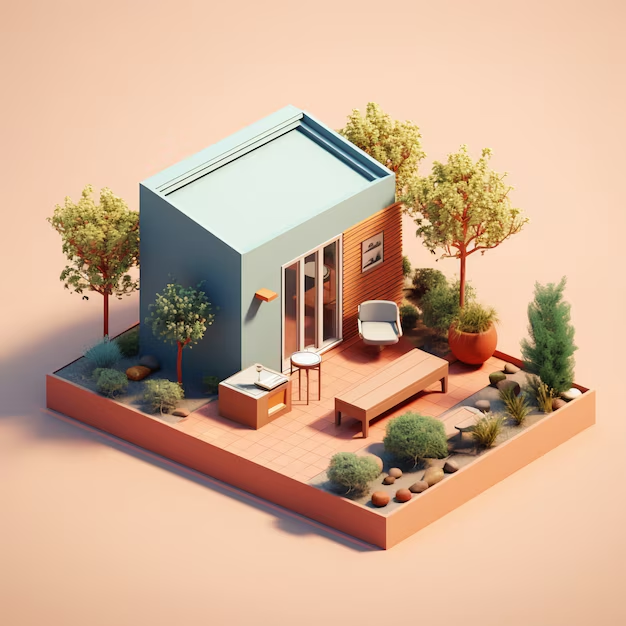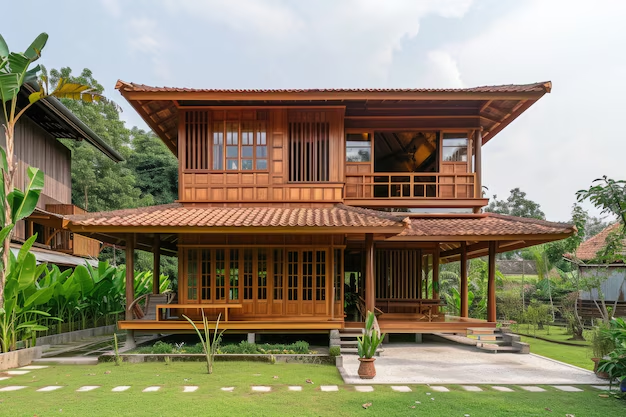Introduction
The dream of owning a home is universal, but the financial constraints often deter many from realizing it. But, with careful planning and design, it is possible to build a comfortable, cheap, one-story house. This guide will explore low-cost, one-story house design. It will provide tips for building a dream home on a budget.
Importance of Efficient Space Utilization
When designing a one-storey house on a tight budget, it’s crucial to maximize the space. Unlike multi-storey homes, a single-storey design must account for the limited vertical space. Efficient space planning avoids unnecessary construction costs. It ensures each area of the home has a clear, functional purpose.
Open-plan layouts are highly effective in low-cost designs. By merging spaces such as the living room, dining area, and kitchen, the need for extra walls is eliminated, reducing construction costs. These open areas also create the illusion of a larger, more spacious home, enhancing the overall ambiance. Also, sliding doors or partitions can flexibly divide the space when needed. They do so without sacrificing openness.
In smaller homes, multifunctional spaces play a vital role. For instance, a living room that can turn into a guest room, or a kitchen with built-in dining, can optimize space and function.
Space Utilization: Maximizing Efficiency in Layout
One of the most effective strategies in low cost one storey house design is the optimization of space. A well-planned layout is crucial to making a small home feel spacious. The goal is to minimize wasted areas, like long hallways and redundant rooms. They add to the square footage but don’t help the home’s function.
- Open Plan Layouts: An open-plan layout is ideal for a low cost one storey house design. Merging the living room, dining area, and kitchen into one space reduces the need for interior walls. This allows for better airflow, natural light, and a feeling of spaciousness. This design not only cuts down on material costs but also simplifies construction. Open plans are versatile, allowing for easy reconfiguration of spaces without extensive renovations.
- Multi-Functional Spaces: In smaller homes, every square foot matters. Designing multi-functional spaces can maximize utility without increasing the home’s footprint. For example, a living area could double as a guest room with a fold-out couch. A kitchen island could serve as both a prep area and a dining table. Furniture with built-in shelves and storage helps clear clutter and conserve space.
- Modular and Compact Rooms: Efficient, compact room designs cut waste. They ensure every inch of the house serves a purpose. For instance, combining laundry and utility rooms into one can save space and costs. Bathrooms and kitchens are often the most expensive parts of a house. This is due to their plumbing and fittings. So, they should be designed for efficiency. One way to save plumbing costs is to put fixtures and appliances that use a lot of water near together.
Simplicity in Architectural Design
- A simple, well-thought-out architectural design is at the core of any low-cost housing project. Design a one-storey house. It must meet all requirements. Avoid unnecessary complexity and extravagance. Simple, attractive designs are inexpensive to construct.
- The overall cost is also influenced by the shape of the house. Compact, rectangular, or square layouts are usually cheaper. They need less complex roofing and foundation work. A symmetrical design with fewer corners simplifies construction. It saves time and materials.
Also, cutting the number of doors and windows can help reduce costs. It must still allow enough natural light and ventilation. Skylights and well-placed windows can let in plenty of daylight. This can reduce the need for artificial light during the day.
Energy Efficiency and Cost Reduction
- An often-overlooked aspect of low-cost one-storey house design is energy efficiency. Building in energy-efficient features from the start can save on utility bills. It will also lessen the environmental effect of the house. Passive solar design is one feature that uses the sun’s energy for heating and cooling.
- The demand for artificial lighting, heating, and cooling can be reduced by positioning the home to take advantage of natural light and breezes. For example, large southern windows let in winter sunlight. Roof overhangs or shades keep the house cool in summer.
To improve the home’s energy performance, use insulated walls and roofs, energy-efficient windows, and reflective roofing. Low-cost homes can benefit from solar panels or water heaters. They save money in the long run, despite the high upfront cost.
Roofing and Foundations: Cost Considerations
The roof and foundation are crucial to a house. They can greatly impact construction costs. For a low-cost, one-storey house, choose durable, cheap materials and methods.
- Roofing Options: A simple, gable roof design is often the most economical choice for a one-storey house. Gable roofs are easy to build. They need fewer materials and drain well. So, they are ideal for areas with heavy rainfall. Metal roofing is a cost-effective and durable option, offering long-term protection against weather elements. Alternatively, corrugated steel sheets or asphalt shingles can be good, cheap roofs. They are durable, too.
- Foundation Types: The foundation type can have a considerable impact on the cost of construction. For a low cost one storey house design, slab-on-grade foundations are typically the most affordable option. This kind of foundation is applied straight to the earth. It does not require a basement or crawlspace. This makes it cost-effective and quick to install. Also, slab foundations provide a strong base for the structure. They are best in regions with stable soil.
Minimalist Aesthetics and Interior Design
In low cost one storey house design, minimalism can be both a stylistic and financial advantage. A minimalist approach to interior design seeks simplicity and function. It aims to eliminate excess. This aligns perfectly with the goal of creating an affordable home.
- Neutral Color Palettes: Neutral colors, like whites, grays, and soft beiges, make spaces feel larger. They also reflect natural light, reducing the need for artificial light during the day. These colors create a clean, uncluttered look. It enhances the sense of openness, which is important in smaller homes.
- Streamlined Furniture: Choose furniture that is both useful and beautiful. It is key to a harmonious design. Multipurpose furniture can help homeowners use limited space. Examples include foldable tables, modular sofas, and beds with built-in storage. Simple shapes and clean, straight lines are common features of minimalist furniture. It fits the theme of efficiency in a low-cost, one-storey house design.
- Natural Light and Open Spaces: We must maximize natural light. It is key to a bright, welcoming atmosphere. Large windows, sliding glass doors, and mirrors can boost the light. This reduces the need for artificial lighting. Open spaces that flow from one room to the next make the house feel larger than it is.

Sustainability in Low-Cost Housing
Sustainability is becoming an integral part of modern low-cost housing design. A one-story house with eco-friendly features and materials has less environmental impact and costs less over time. Sustainable practices include: using locally sourced materials, reducing waste in construction, and using energy-efficient technologies.
Reclaimed wood and recycled metal are two examples of recycled materials that can reduce expenses. They also give the home a unique, characterful look. Also, sustainable materials like bamboo can be used for flooring, cabinetry, and other finishes. It is fast-growing and highly renewable.
Also, using rainwater harvesting, solar power, and natural ventilation can create a self-sufficient home. It would rely less on external resources, making it cheaper to maintain.
Conclusion
A low-cost, one-storey house needs a balance of efficiency, beauty, and sustainability. On a tight budget, homeowners can design a stunning and practical room. They should use space wisely. They should use cheap materials, simple designs, and energy-efficient systems. A low-cost, well-designed home meets the need for affordable housing. It also has long-term benefits. These include lower maintenance, energy savings, and a smaller environmental impact.
A low-cost, one-storey house design must succeed. It must provide a comfortable, attractive, and sustainable home. It should meet its occupants’ needs and stay within budget.